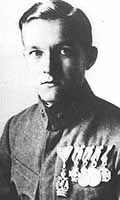Oberleutnant Franz Rudorfer (1897-1919) was an Austro-Hungarian World War I flying ace credited with eleven confirmed and two unconfirmed aerial victories.[1]
Franz Rudorfer | |
|---|---|
 Franz Rudorfer.jpg | |
| Born | 29 July 1897 Vienna, Austria |
| Died | 19 November 1919 |
| Allegiance | Austro-Hungarian Empire |
| Service/ | Infantry; aviation |
| Years of service | 1914–1919 |
| Rank | Oberleutnant |
| Unit | Flik 19D, Flik 51J |
| Awards | Order of the Iron Crown, Military Merit Cross |
| Other work | Pioneered European civil aviation |
Early life edit
Franz Rudorfer was born on 29 July 1897 in Vienna, Austria, when it was still part of the Austro-Hungarian Empire.[2]
World War I edit
Rudorfer had volunteered for service before World War I began.[3] He was posted to Infanterieregiment No. 59 as a new leutnant in August 1916. In May 1917, he requested transfer to aviation. His first posting after observer training at Wiener-Neustadt was Flik 19J on the Italian front, under the command of Adolf Heyrowsky. Here he scored his first victory, becoming a balloon buster on 15 November 1917. It was also during his Flik 19J assignment that Rudorfer began to teach himself to fly.[1][3] He would become a pilot without undergoing formal training.[2]
In April 1918, he was posted to Flik 51J to fly Albatros D.III fighters.[1] Between 17 April and 27 October 1918, he reeled off confirmed victories over eight enemy airplanes and two more observation balloons, along with two unconfirmed.[3] During the crucial Battle of Vittorio Veneto, Rudorfer was one of the few Austro-Hungarians flying, bringing down a balloon on 24 October, and a couple of Sopwith Camels on the 27th. He would score no more victories before the war ended on 11 November 1918.[1]
Postwar career edit
On 30 December 1918, Franz Rudorfer received Austrian Pilot's Certificate No. 2647.
Franz Rudorfer died of unknown causes on 13 November 1919.
Notes edit
- Flik = Fliegerkompanie, a basic Air Force unit of Squadron size though was often understaffed numbering on average 8 pilots. [4]
- Flik with'J' = 'J' denoted Jagdfliegerkompanie which was composed of dedicated Fighter aircraft.[4]
- Flik with 'F' = 'F' Fernaufklärerkompanie was the designation for a Long Range Reconnaissance unit such as Flik 47F. [4]
Sources of information edit
- ^ a b c d Austro-Hungarian Aces of World War 1. pp. 78–79.
- ^ a b Above the War Fronts: The British Two-seater Bomber Pilot and Observer Aces, the British Two-seater Fighter Observer Aces, and the Belgian, Italian, Austro-Hungarian and Russian Fighter Aces, 1914-1918: Volume 4 of Fighting Airmen of WWI Series: Volume 4 of Air Aces of WWI, p. 198.
- ^ a b c The Aerodrome website [1] Retrieved on 5 April 2010.
- ^ a b c Air aces of the Austro-Hungarian Empire, 1914-1918, p. 258.
References edit
- Chant, Christopher (2002). Austro-Hungarian Aces of World War 1. Osprey Publishing. ISBN 978-1-84176-376-7.
- Franks, Norman; Guest, Russell; Alegi, Gregory (1997). Above the War Fronts: The British Two-seater Bomber Pilot and Observer Aces, the British Two-seater Fighter Observer Aces, and the Belgian, Italian, Austro-Hungarian and Russian Fighter Aces, 1914–1918. Grub Street. ISBN 978-1898697565.
- O'Connor, Martin (1994). Air Aces of the Austro-Hungarian Empire 1914 - 1918. Flying Machines Press. ISBN 978-0-9637110-1-4.
- Герої українського неба - пілоти визвольної війни 1917-1920 рр. Ярослав Тинченко. Темпора, 2010. ISBN 978-966-8201-94-3.